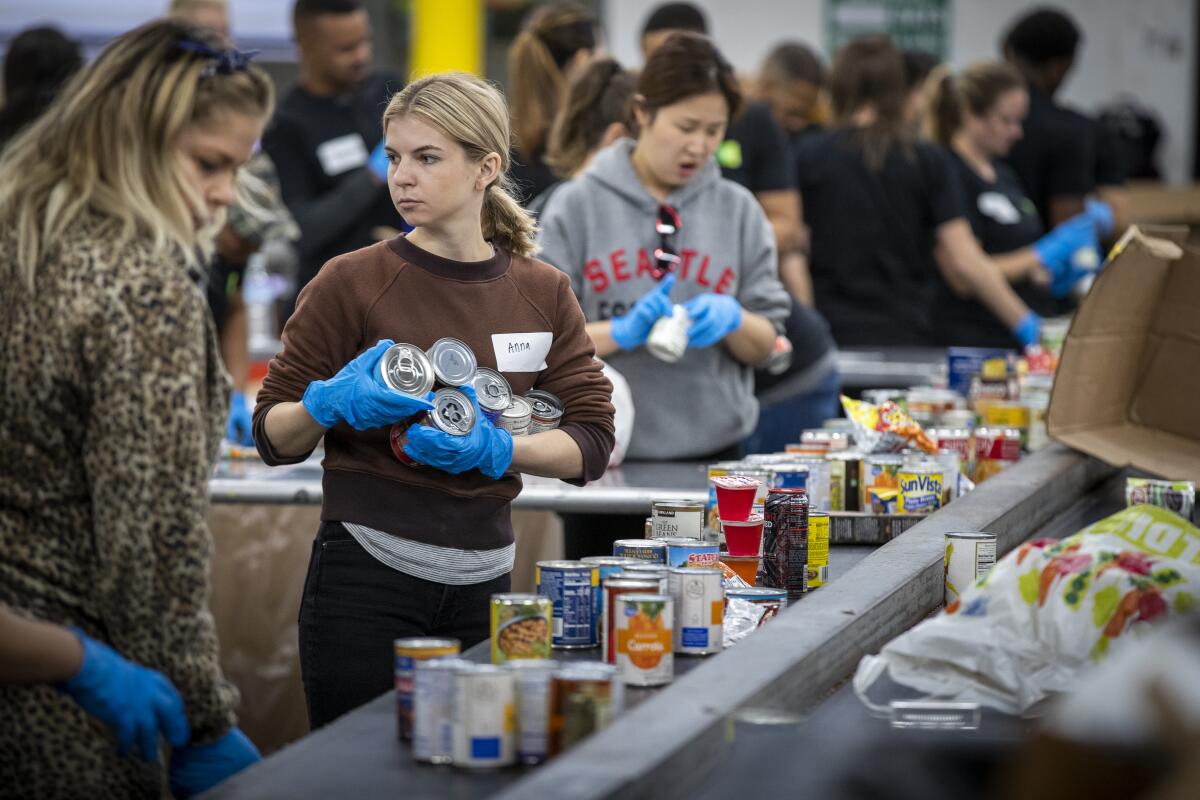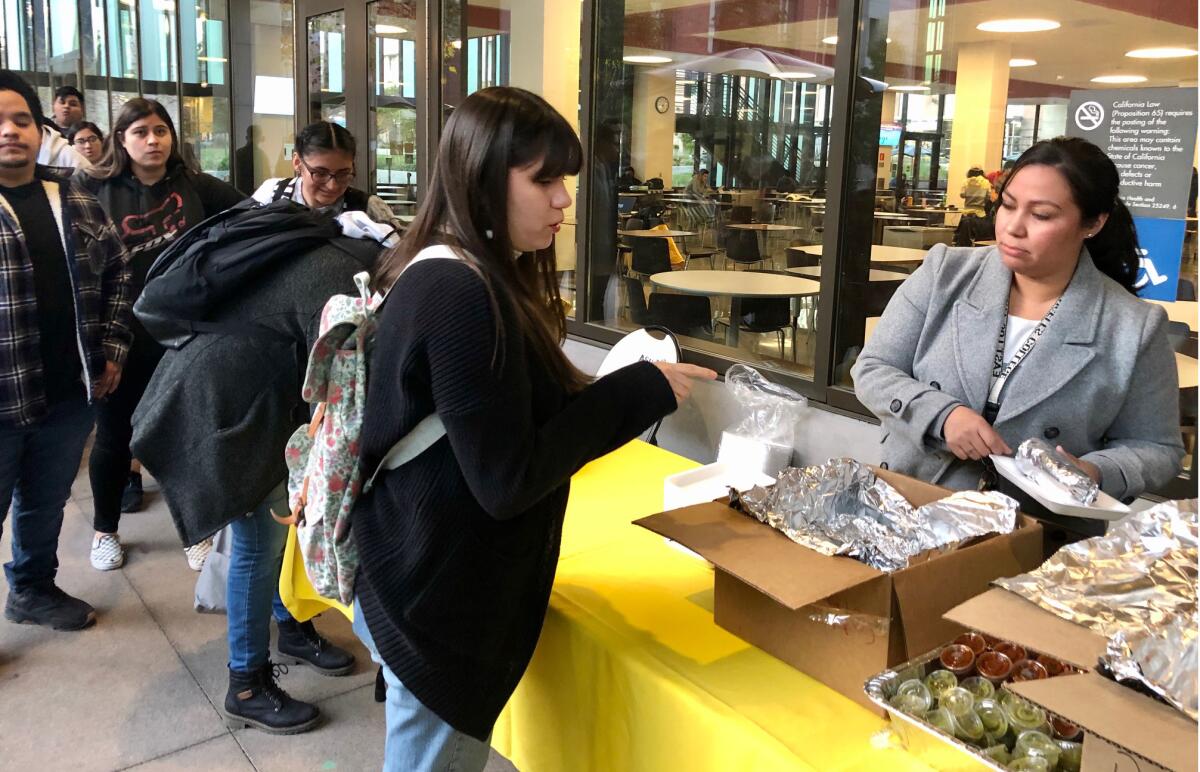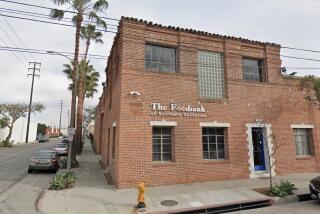Column: College students don’t have enough money to eat. Their classmates are feeding them

- Share via
The window of the food pantry is in an inconspicuous location on the second floor of the student services building at East Los Angeles College, and that’s for the best. Some of the students who come here don’t want the whole campus to know they’re hungry.
“It’s really a sensitive topic for some people,” said Anthony Dominguez, a biochemistry major who sometimes works at the pantry and hands out packaged noodles, granola bars, energy drinks and other items.
After I spoke to Dominguez, I watched a student sidle up to the window and show his ID. He was handed a pouch of apple sauce and a granola bar, then walked away.
But he lingered nearby, watched me interview another pantry customer, then approached.
“It was awkward the first couple of times I came,” he said, asking me to identify him by his initials, J.C.
J.C. told me he lives in a South Los Angeles neighborhood that sees a lot of violence. He said he has lost friends and cousins to murder, and he wants to become a homicide detective to bring killers to justice.
His dad is a janitor and his sister takes care of their ailing mother, a dialysis patient. If there’s food at home he’ll eat there, but there’s not always enough to go around. A counselor told him about the pantry.
“I just broke down,” he said of his conversation with the counselor. “I told her I was struggling.”

So are a lot of students. Armond Aghakhanian, chief development officer for the East Los Angeles College Foundation, says a recent poll found that 70% of the school’s students “have experienced hunger/food insecurity.”
That’s a startling statistic, but not a surprising one. The Times reported two years ago that in the nine-campus Los Angeles Community College District, 65% of the 230,000 students couldn’t afford balanced meals and nearly one in five had been recently homeless, according to a district study.
But there’s some good news along with the bad.
The pantry in the student services building is one of several on campus, and professors and staff are among the donors to them. The Los Angeles Regional Food Bank has outreach workers on campus, enlisting eligible students in the state’s CalFresh food program. And the same food bank, which sends a mobile pantry to Pasadena City College, Citrus College and Cerritos College, hopes to add East L.A. College to the list.
Aghakhanian told me the ELAC Foundation has also challenged donors and restaurants to feed hungry students, and hundreds of vouchers have already been distributed. Eligible students are given a minimum of 21 $5 vouchers, and participating restaurants include Armando’s Mexican restaurant, Carrows, La Azteca Tortilleria, McDonald’s, Pacific Dining Food Management Services, Panda Express, So-Cal Burgers Chill & Grill, Tamales Lilianas and Z’s Crazy Good.
Student George Gurrola, 46, said he dines at Z’s Crazy Good with the vouchers, and they’re a big help. He said he served in the Marines for six years, later got a degree in business and worked for five years as a website designer before getting laid off.
He couldn’t find anything that matched his salary, so he moved in with his parents, got a job as a security guard and went back to school for a master’s in marketing. With the help of an East L.A. College program designed to encourage local entrepreneurship, Gurrola has started a sport sandal business. He wants it to be based in Boyle Heights and he plans to hire from the neighborhood, but his budget is tight for now, and the burgers at Z’s Crazy Good are a godsend.
“I’m not sure what’s normal, but I’m pretty much eating rice and beans at the moment,” he said when I asked if there’s enough food to go around in his parents’ home. “It’s bare bones. My parents are retired and just don’t have the money, and I don’t want to be a burden on them. I should be supporting them, and not the other way around, so I feel bad about that.”
Gabriel Buelna, a member of the Los Angeles Community College Board of Trustees, told me he’d like to expand the voucher program to every campus in the district, but he also wants to remove the stigma students might feel about using food coupons.
“Let’s get the relationship with the restaurants and create a bureaucracy-free system where you can go and get the food and the restaurants get reimbursed because we went and got the donors,” Buelna said.
He said that in East L.A., for instance, participating restaurants can offer “an ELAC special.” Maybe it’s a “bean and potato and egg special with three types of mole,” and instead of the usual $7, it’s $1.99 or maybe even 99 cents if you flash your student ID. Students would get fed, restaurants would groom long-term customers and community colleges would take a step toward becoming colleges of the community, Buelna said.
Around this time of year, I always hear from readers asking for recommendations on good causes to donate to. If you’d like to support the ELAC food program, you can get information at www.elacfoundation.com
Or you could help support the L.A. Regional Food Bank’s mobile pantry expansion by going to LAFoodBank.org/donate, or get more information on that program by emailing Roger Castle at [email protected].
I stopped by the food bank Friday, and Chief Executive Michael Flood said more food has been donated this year and more food has been distributed than ever before in the nonprofit’s 46-year history.
The reason for the growing demand is that despite low unemployment rates and the fact that California has the world’s fifth-largest economy, low wages and the high cost of housing have pushed millions of residents to the brink. Flood said one reason for the increase in donations is the U.S. tariff war with China. Food producers unable to sell their goods overseas are making substantial donations of frozen meats, fresh produce and nuts.
More than 30,000 people a year volunteer to work at the food bank, and on Friday, employees from Zappos and UDR Apartments worked the assembly line, sorting and packing donated food for pickup and distribution throughout the county. Volunteer coordinator Ana Martinez said the food bank is good through the end of the year, but more volunteers will be needed after the holidays and well beyond, because hunger isn’t going away.
So many of our social and economic problems are overwhelming; it’s easy to get discouraged or to think there’s no way for an individual to make a difference.
But hunger — whether it’s in the homes of our neighbors or on college campuses — shouldn’t exist in the richest nation on the planet.
And there are ways for each of us to make a difference.
More to Read
Sign up for Essential California
The most important California stories and recommendations in your inbox every morning.
You may occasionally receive promotional content from the Los Angeles Times.











